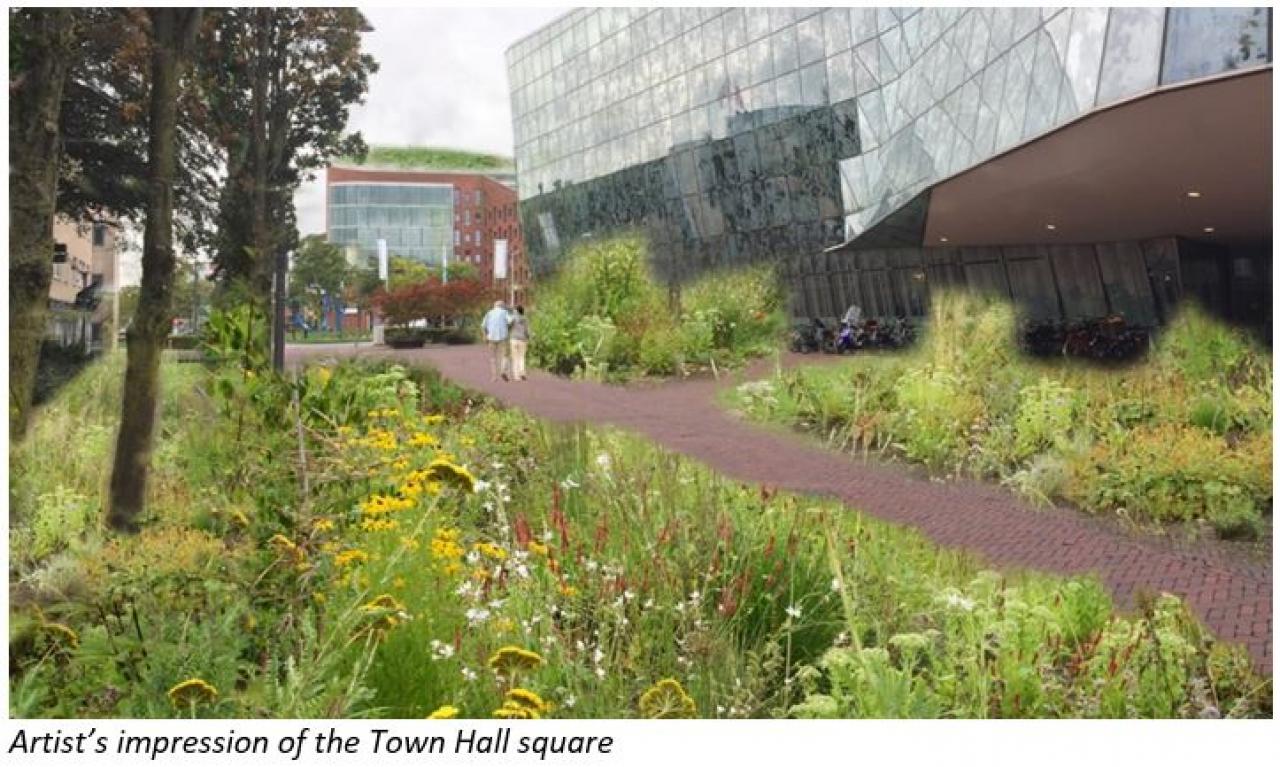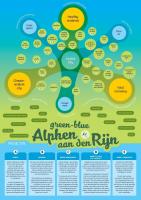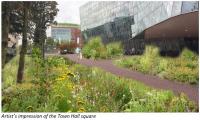
Alphen aan den Rijn is a municipality in the Dutch province of South-Holland. Originally a Roman city, it industrialised in the 19th and 20th centuries. The outlying area and villages are centred around agricultural activity, including the village of Boskoop, which is famous for its 560 plant nurseries. This green backyard is an important economic pilar of Alphen aan den Rijn and will play an important role in its healthy city planning.
In recent years, Alphen aan den Rijn has been increasingly challenged by the consequences of population growth, climate change and the 24-hour economy. To make the most of limited space, greenery has been sacrificed for density. The city is also increasingly congested, and the health of both people and nature are under pressure, thanks to air pollution, heat stress, drought and flooding, and unhealthy lifestyle factors. To reverse this process Alphen aan den Rijn has committed to improving health for people and nature with a Green-Blue program.

A. Health
B. Greening
C. Water management
D. Smart & clean city logistics
E. Energy transition
A. Use Green and Blue for Healthy Lifestyle and Clean Air
During the project, children in local schools will learn to appreciate the importance of nature, healthy food and exercise. Health Tracks in the city center provide an easy exercise option to get young and old moving. By establishing a healthy lifestyle early, we can prevent health problems down the line.
Alphen is also committed to improving air quality. This means removing the main causes of air pollution by establishing sustainable mobility and a sustainable energy supply (see D and E), and helping to clean the air with air-purifying green plants (see B). Local growers and gardeners in the region are involved, supplying plants, fruit and vegetables for schools and air-purifying greenery.
B. Green the City to Increase attraction and Biodiversity
To make the city center more attractive and sustainable, Alphen plans to add green spaces, roofs and walls, including public gardens and roadsides filled with flowers. This will make the center more appealing, and also help absorb heavy rainfall and purify the air (see C).
Construction and maintenance will be set up in collaboration with parties from Greenport Boskoop nurseries. Their expertise will be used to select plants that suit urban conditions, are easy to maintain and contribute to biodiversity. With long-term maintenance contracts, (regional) green parties will ensure that the greenery remains beautiful and have sufficient water ("green-as-a-service"). A Green Fund is being established to offer property owners financing for greening their property.

C. Use Green and Blue to Tackle Extreme Rainfall, Drought and Heat While Enhancing Appeal
Climate change means we are experiencing extreme rainfall, heat and drought increasingly often. This threatens the health, safety and property of city residents, businesses and the municipality.
By draining and storing water in the soil, basins, ponds and green roofs, the risk of flood damage to buildings and infrastructure is reduced. Storing the water also helps deal drought, provising a water source for plants. Trees also cool the space around them, making the city centre more pleasant and safe during the hot summer months.
D. Renew Urban Logistics, Improve Accessibility, Road Safety and Air Quality
Urban logistics are crucial for city economies. Efficient city logistics ensure that shops receive goods on time, waste is collected, restaurants can serve their guests, and online orders are delivered. Due to population growth and increasing online shopping, almost all Dutch cities are facing an increase in trucks. More trucks mean more emissions that are detrimental to health, and the increased traffic also reduces quality of life, accessibility and safety in cities.
To tackle this challenge, Alphen has invested in smart logistics and electric vehicles to efficiently supply the city center without emissions. By sharing transport, using logistics hubs and combining supply and return, the number of trips will decrease. With fewer vehicles in the city and more stock at logistics hubs, space is created on the streets.
E. Reduce Energy Consumption, Generate Renewable Energy, Reduce CO2 Emissions
Mitigating climate change has never been more important. To help keep the world below 2° C of warming, the Dutch climate agreement aims to reduce CO2 emissions by 49% by 2030, with a 95% reduction of emissions by 2050.
To achieve this, companies and residents need to drastically cut CO2 emissions. For Alphen, this means moving to renewable energy, insulating homes, switching to LED lighting, encouraging cycling and electric vehicles.
GREEN AND BLUE CITY HEART
Alphen’s Green-Blue program is as ambitious as it is realistic. It offers serious opportunities to improve the city in a sustainable manner, with broad social and economic effects. The five themes are interconnected, enhancing the effects. The strength of this program lies in that connection; by investing in water and greenery, the city is capitalizing on the blue-green value that nature offers to build a vital, attractive home for future generations.
Healthy School Meals Pilot
The 1st March saw the start of the healthy school meals pilot at two local schools. Over 100 children between 8-10 years old are served healthy lunches, delivered by zero-emission vehicles and accompanied by a video of the chef discussing the ingredients. As classes consist of at least 14 different nationalities, once a week there will be a be a cultural theme that defines the day’s menu, so children learn about each other’s cultural backgrounds.

Greening the Town Square
A team has begun to map the possibilities for greening the Stadhuisplein (Town Hall square). This square is currently a shared space and almost completely paved. As such, the design needs completely reconsidering to pivot to a health perspective. This requires new thinking for all the disciplines involved, from traffic and public transport to safety, cables, pipes and landscaping. An intensive process of learning lies ahead.

Covid-19 Delays Pilots
In 2020 Alphen began a pilot of greening projects in the city center designed to inspire shop owners to take greening action. A flower strip on a shopping street was proposed. However, local shop owners resisted. Following months of lockdown, the shop owners feared that the green strip would obstruct access to their entrances. Economically, shops are enduring a difficult time, and are particularly wary of physical obstructions or financial risks. As such, the pilot plan is ready, but following consultation with shop owners has been postponed six months.

A Green Future
With the challenges posed by Covid-19, big steps forward in Alphen’s plan will take time. However, even in these initial stages, the project has been met with energy and enthusiasm from stakeholders, excited to witness the transformation of Alphen aan den Rijn into the healthy city they believe it could be.
Alphen aan den Rijn’s journey through these difficult times has been aided by the support and inspiration of their partner cities. Additionally, URBACT’s tools have helped Alphen aan den Rijn plan participation with local stakeholders, improve the process, and take steps forward.
By Margreet Boer, city of Alphen aan den Rijn

